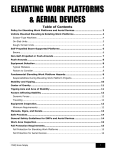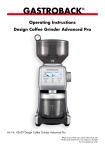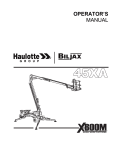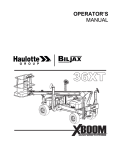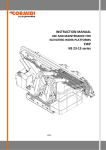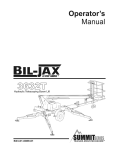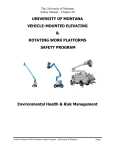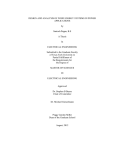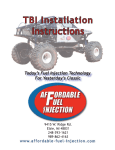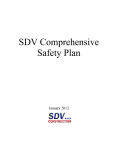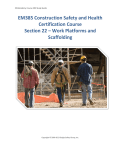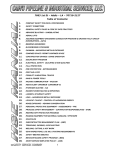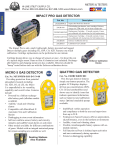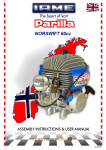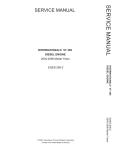Download ELEVATING WORK PLATFORMS & AERIAL DEVICES
Transcript
ELEVATING WORK PLATFORMS & AERIAL DEVICES This company has adopted this program for the safety of employees when working on or around “Vehicle Mounted Elevating and Rotating Work Platforms” from OSHA regulations. The safety coordinator is designated by this company as the competent person in authority over all aerial device work procedures. The safety coordinator will ensure that all safety measures and systems are in place and correctly installed, all safety procedures are adhered to, and ensure regular inspections of the operational site and aerial equipment are made. This company has implemented and will enforce the following work practices and procedures to assure that no employee will be exposed to hazards during aerial lifting operations: • • • • • • • • The safety coordinator will confirm and verify that all employees are trained in and familiar with required work practices and procedures in the use of any equipment required, proper PPE, and safety procedures which must be followed to safeguard personnel involved in aerial lifting operations or who work in the vicinity of aerial lifting operations. Only trained and authorized personnel will be permitted to operate equipment. Each work platform will be inspected, maintained, repaired, and kept in proper working order in accordance with the manufacturer's maintenance and repair manuals. Any work platform not in safe operating condition must be removed from service until it is repaired. All repairs will be made by a qualified service person in conformance with the manufacturer's operating, maintenance, and repair manuals. Modifications or alterations of work platforms will be made only with written permission of the manufacturer or any other equivalent entity. Each work platform will be equipped with a mechanical parking brake, which will hold the unit on any slope it is capable of climbing. When possible, wheel chocks will be installed before using an aerial lift on an incline. The following information will be displayed on all work platforms in a clearly visible, accessible area and in as permanent a manner as possible: o Warnings, cautions, or restrictions for safe operation in accordance with ANSI requirements o The rated work load will be clearly displayed at each entrance to the platform. Before using the work platform, the operator must: o Read and understand the manufacturer's operating instructions and safety rules, and be trained by a qualified person on the contents of the manufacturer's instructions and safety rules. o Read and understand all decals, warnings, and instructions on the work platform. o On a daily basis, before the work platform is used, it must be given a thorough inspection, which must include: Inspection for defects such as cracked welds, hydraulic leaks, damaged control cable, loose wire connections, and tire damage. Inspection of functional controls for proper operation. Any suspect items discovered through inspection must be carefully examined and a determination made by a qualified service person as to whether they constitute a safety hazard. All unsafe items must be corrected before further use of the work platform. ©2014 Safety Services Company w ww .sa fe tyse rvic e sc o mp a ny.c o m Page 1 ELEVATING WORK PLATFORMS & AERIAL DEVICES • Before the work platform is used, the operator must survey the area for hazards such as: o Untamped earth fills. o Ditches. o Dropoffs or holes. o Bumps & floor obstructions. o Debris. o Overhead obstructions and high-voltage conductors. o Other possible hazardous conditions. • Before each elevation of the work platform, the operator must: o Check for overhead obstructions and high-voltage conductors. A minimum distance of ten feet from energized high-voltage conductors must be maintained at all times between the conductors and the operator and platform equipment. o Ensure that the load and its distribution on the platform are in accordance with the manufacturer's rated capacity. The manufacturer's recommended load limits must never be exceeded. o Ensure that outriggers and stabilizers are used if the manufacturer's instructions require their use. o Ensure that guardrails are properly installed and gates are closed. • Before and during driving while the platform is elevated, the operator will: o Be required to look in the direction of, and keep a clear view of, the path of travel and assure that the path of travel is firm and level. o Maintain a safe distance from obstacles, debris, drop-offs, holes, depressions, ramps, or other hazards to safe elevated travel. o Maintain a safe distance from overhead obstacles. • The operator must limit travel speed according to conditions. Conditions to be observed are: Ground surface, congestion, slope, location of personnel, and other factors that may create a hazard of collision or injury to personnel. • Stunt driving and horseplay is prohibited. • Personnel must maintain a firm footing on the platform while working thereon unless they are secured by safety harness and lanyard devices fixed to manufacturer-approved anchor points. Use of railings or planks, ladders or any other device on the work platform for achieving additional height is prohibited. • The operator will immediately report defects or malfunctions which become evident during operation and must stop use of the work platform until correction has been made. • Altering or disabling of safety devices or interlocks is prohibited. ©2014 Safety Services Company w ww .sa fe tyse rvic e sc o mp a ny.c o m Page 2 ELEVATING WORK PLATFORMS & AERIAL DEVICES VEHICLE MOUNTED ELEVATING & ROTATING WORK PLATFORMS Basic Types of Elevating Work Platforms and Aerial Devices There are two basic types of elevating work platforms – boom and scissor. Both types come in: “On-Slab” models for use on smooth hard surfaces such as concrete or pavement. “Rough-Terrain” models for use on firm level surfaces such as graded and compacted soil or gravel. Both types share three major components: base, lifting mechanism, and platform assembly. SCISSOR-TYPE MACHINES These are raised and lowered by hydraulic pistons and an expanding scissor mechanism. Platforms are available in various configurations with different capabilities for extension and movement. Some have extendable platforms or platforms that can rotate. Extendable platforms should be retracted before raising or lowering the device. Typical machines are illustrated in Figure 1. On-Slab Units • • • • • Not designed for uneven or sloping ground. Normally have solid rubber tires. Generally powered by rechargeable DC battery. Some are powered by internal combustion engine, either gasoline or propane. Most have “pothole protection” – a metal plate lowered close to the ground to afford some protection against inadvertent movement into depressions or debris. ©2014 Safety Services Company w ww .sa fe tyse rvic e sc o mp a ny.c o m Figure 1 Page 3 ELEVATING WORK PLATFORMS & AERIAL DEVICES Rough-Terrain Units • • Similar in design to on-slab machines. Built to handle rigorous off-slab challenges FIGURE 1: Scissor-type Powered • Normally have wider wheel bases, larger wheels, and pneumatic tires. • Some fitted with outriggers for extra stability. • Usually powered by internal combustion engines: gasoline, diesel, or propane. • DC Battery powered units are also available, but are not common. • Lifting mechanism is hydraulic. Scissor-lifts range in capacity from 500 to several thousand pounds. They are available with platform heights often reaching 50 feet or more. Scissor-lifts must be set up on stable, level ground, even with outriggers deployed. A slight imbalance or instability is amplified when the machine is raised. Figure 2 shows one example of controls. Although fixed to the platform, the controls are moveable from one side of the platform to the other. This enables the operator to see the path of travel. The controls must be oriented correctly so that the operator does not inadvertently move the machine in the wrong direction. Many machines have color-coded directional arrows on the chassis to aid the operator in moving the machine. FIGURE 2: Example of Controls on Scissor-Type Platforms 1 11 11 TYPICAL CONTROLS 1. 2. 3. 4. 5. 6. 7. 8. 9. 10. 11. Emergency stop button Choke 11 11 Glow plugs (diesel engines only) Stop/ start switch Run/idle switch 7 6 Lift up/down switch Drive high range/low range switch 1 Forward/reverse joystick Left/right steer switch Traversing deck out/in switch 8 Outriggers up/down switch ©2014 Safety Services Company w ww .sa fe tyse rvic e sc o mp a ny.c o m Page 4 ELEVATING WORK PLATFORMS & AERIAL DEVICES Self-Propelled BoomSupported Platforms Normally fitted with rough-terrain undercarriages. Some smaller on-slab units. Platforms have lifting capacity of about 500 pounds or two workers. Lack capacity of scissor-type machines; not intended for lifting materials. Usually powered by an internal combustion engine: gasoline, diesel, or propane. Booms • • • Telescopic, articulating, Raised and extended Can reach up to 150 feet. or combination of both. by hydraulic cylinders. Platforms • Can extend well beyond the wheelbase. Figure 4 shows one example of controls for a boom machine. Although controls are fixed in position, the operator may become disoriented by machine rotation and must remain aware of the direction of movement. Many machines have color-coded directional arrows to help the operator move the machine in the right direction. MAIN LIFT & SWING CONTROLLER PLATFORM LEVEL STEER SELECT ENGINE START & LIGHTS AUXILIARY POWER POWER & FUEL EMERGENCY STOP INDICATOR PANEL DRIVE & HORN STEER DRIVE SPEED TOURQUE SELECT MAIN TOWER FUNCTION SPEED PLATFORM ROTATE TOWER LIFT TELESCOPE TELESCOPE ARTICULATING JIB BOOM FIGURE 4 Mobile Controls ©2014 Safety Services Company w ww .sa fe tyse rvic e sc o mp a ny.c o m Page 5 ELEVATING WORK PLATFORMS & AERIAL DEVICES As with mobile cranes, stability decreases with length of boom and boom angle as the center of gravity moves in relation to the platform position. The machine will overturn if the center of gravity moves outside the machine’s base. Machines come with load charts that show safe operating configurations. Machines with booms long enough to cause overturning at low boom angles are required to have radiuslimiting interlocks to prevent operation in unstable configurations. The reach chart shown in Figure 5 indicates the safe operating configurations for a machine with 120 feet of reach operating on a level surface. The reach diagram in Figure 6 shows the safe operating envelope for a 36-foot boom machine. Notice that the machine does not achieve its maximum height directly overhead. Nor does it achieve its maximum reach at ground level. Users must be familiar with the operating range of the individual make and model of the equipment they are using. This knowledge is essential in order to position the machine correctly and reach the work location safely. NON-SELF-PROPELLED OR PUSH-AROUNDS As the name indicates, these units are not selfpropelled and must be transported from one location to another with an independent power source or manually in the case of the smaller devices. The machines are intended primarily for use on smooth, level, hard surfaces or on- slab conditions. Some trailer- mounted units are available. Many of these devices can fold up to pass through a standard door and can be transported by pick-up truck. As a result, they are suitable for maintenance or renovation work. ©2014 Safety Services Company w ww .sa fe tyse rvic e sc o mp a ny.c o m Page 6 ELEVATING WORK PLATFORMS & AERIAL DEVICES PUSH-AROUNDS Raising mechanism normally powered by gasoline or propane engine or by electric motors, either AC or DC. Normally raised and lowered by hydraulic cylinders. Platform capacities vary from 300 to 1000 pounds or more but are generally less than 500 pounds. Devices with capacity less than 500 pounds are Not Recommended for construction—this type is better suited to maintenance activities. Platforms usually do not exceed 36 feet in height. As platform is raised, risk of overturning increases. Extra care required when operating at maximum height. EQUIPMENT SELECTION Elevating work platforms are designed for different uses. It is essential to select the appropriate equipment for the job. Typical Mistakes • • • • • Using an on-slab machine on rough terrain. Using a unit undersized with respect to height, reach, and lifting capacity. Lifting large materials that overhang the platform. Using a scissor lift where the reach of a boom-type machine is needed. Extending the platform with planks, ladders, or other devices because the machine cannot reach the required height. Factors to Consider • • • • • • Capacity – Does the machine have the lifting capacity, the reach, and the height to complete the task? Surface Conditions – Are the surface conditions hard or soft, sloped or level? Will the ground have an effect on the type of machine selected? Platform Size and Configuration – Do you need a regular or extendable platform? Is rotation required? Are there space restrictions to consider? Mobility – Is a boom type better suited than a scissor lift to the task at hand? Material to be Lifted – Will the machine be able to lift the size and weight of material required for the job? Access – Will the machine be able to travel around the workplace safely? Are there obstructions or depressions that will restrict the use of certain machines? ©2014 Safety Services Company w ww .sa fe tyse rvic e sc o mp a ny.c o m Page 7 ELEVATING WORK PLATFORMS & AERIAL DEVICES • • Operator Skill or Training – Are the people on site competent to operate the machine? If a propane-powered engine is used, has the operator received propane training? Work Environment – If the work is to be done indoors, or in a poorly ventilated area, will an electrically powered machine be required? FUNDAMENTAL ELEVATING WORK PLATFORM HAZARDS The following are some of the basic hazards to be aware of during operations: Machine Tipping or Overturning – Many factors cause instability – sudden stops, depressions, drop-offs, overreaching, overloading, etc. Overturning and tipping result in many fatalities and injuries. • Overriding Safety Features – Disarming features such as the tilt or level warning and the deadman switch can prevent operators from knowing when they are in a dangerous situation. Overriding the deadman switch has resulted in fatalities; so has malfunction of the tilt warning. • Overhead Power line Contact – Contacting overhead wires can cause electrocution. This can happen with any type of machine – and with the loads carried by or overhanging the machine. • Falls from Elevated Platforms – Many falls occur because workers get in a hurry and fail to observe standard fall protection procedures. Many such falls cause serious injury or even fatalities. • Makeshift Extensions – When the machine cannot reach the working height desired, do not compensate by using scaffold planks, ladders, blocks of wood, or other makeshift arrangements. Such practices lead to falls and machine instability. • Overloading the Platform – Elevating work platforms overloaded or loaded unevenly can become unstable and fail. Boom-type machines are especially sensitive to overloading. Always stay within the operating range specified by the manufacturer. • Failure to Cordon Off – o Elevating work platforms have been struck by other construction equipment or oncoming traffic when the work area is not properly marked or cordoned off. o Workers have been injured when they inadvertently entered an unmarked area and were struck by falling material, tools, or debris. o In unmarked areas, workers have also been injured by swinging booms and pinched by scissor mechanisms. • Accidental Contact – Many elevating work platforms have blind spots. Moving the machine or platform may cause contact with workers or with obstacles. Use a designated signaller on the ground to guide the operator when the path of travel is not clear or access is tight. • Improper Maintenance or Modifications – Elevating work platforms should be maintained by competent workers in accordance with manufacturer’s instructions. • ©2014 Safety Services Company w ww .sa fe tyse rvic e sc o mp a ny.c o m Page 8 ELEVATING WORK PLATFORMS & AERIAL DEVICES • • • • • No modifications should be made to the machine without the manufacturer’s approval. Improper Blocking During Maintenance – Failing to block, or improperly blocking the machine, boom, or platform can cause serious crushing injuries and property damage. Improper Access – Do not enter or leave the platform by climbing the scissors or the boom. Do not use extension ladders to gain access. Ladders exert lateral loads on the platform that can cause overturning. For the safest access, lower the machine completely. Moving with Platform Raised – Lower the platform before moving the machine unless: o The machine is designed to move with platform raised. o The supporting surface is smooth and level. Slight dips and drops are amplified when the platform is raised and can cause the machine to overturn. Improper Refueling – Take care when refueling. Gasoline, for instance, should be kept in approved containers and dispensed to prevent spills and sparking. Pinch Points – Clothing, fingers, and hands can get caught in scissor mechanisms. As platforms are raised, machines may sway. Workers can be pinched between guardrails and the structure. Position the platform so that work takes place above guardrail height. ©2014 Safety Services Company w ww .sa fe tyse rvic e sc o mp a ny.c o m Page 9 ELEVATING WORK PLATFORMS & AERIAL DEVICES RESPONSIBILITIES DURING ELEVATING WORK PLATFORM PROJECTS Because elevating work platforms are often rented from an equipment supplier, there is confusion as to the responsibilities of the parties involved. Generally, the responsibilities can be summarized in the following way: The owner or supplier must ensure that the machine: • • • Is maintained in good operating condition. Conforms to appropriate regulations and standards. Includes the operator’s manual and correct load rating charts. The employer and supervisor on the project must: • • • • • • • Ensure that the operator is fully trained and is competent to operate the particular equipment being used. Ensure that the machine has the correct load rating capacity for the job. Maintain the equipment and all its protective devices. Maintain a daily inspection log for each platform. Ensure that workers use appropriate personal protective equipment. Keep the manufacturer’s operating manual with the equipment. Train workers on each type of equipment that they will be using. The operators and workers using the equipment must: • • • • • • • Receive adequate training to be fully competent. Only operate the machine when competent. Operate the machine in a safe manner as prescribed by the manufacturer according to Company safety and health policies. Inspect the equipment each day or each shift before use. Perform function tests before use. Report any defects to the supervisor. Read, understand, and obey the manufacturer’s safety rules, including operating manual and warning decals. When a defect is reported to supervisor, the equipment must be taken out of service until the repairs completed and the equipment is inspected and approved for use. and the the are STABILITY AND TIPPING In general, elevating work platforms are well manufactured and are safe to use within their specific limitations. However, as with any equipment or tool, there are do’s and don’ts to follow. One of the most dangerous hazards in operating elevating work platforms is tipping over. This can be caused by one or more of the following factors: • • • • Sudden movement of the unit or parts of the unit when elevated. Making sudden stops while in motion with platform elevated. Uneven or overloading of the platform. Traveling or operating on a slope or uneven terrain. ©2014 Safety Services Company w ww .sa fe tyse rvic e sc o mp a ny.c o m Page 10 ELEVATING WORK PLATFORMS & AERIAL DEVICES • • • Changing the weight distribution of the machine by replacing parts with others of a different weight or adding attachments not approved by the manufacturer. Holes or drop-offs in the floor surface causing one wheel to drop suddenly. Operating the equipment in windy conditions (refer to the operator’s manual for safe operating conditions). It is important that users understand what makes a platform stable and what causes it to overturn. To understand stability, one must understand the concept of center of gravity, tipping axis (or tipping point), and forces that shift the center of gravity. Stability is resistance against tipping over. Stability depends on the location of the center of gravity in relation to the tipping axis. CENTER OF GRAVITY Every object has a center of gravity. It is the point where the object’s weight would be evenly distributed or balanced. If a support is placed under that point, the object would be perfectly balanced. The center of gravity is usually located where the mass is mostly concentrated. However, the location does not always remain the same. Any action that changes the machine’s configuration – such as raising the platform, extending the boom, or traveling on a slope – can change the location of the center of gravity. Figure 8 shows how raising a scissor-type platform affects the center of gravity. Figure 8 TIPPING AXIS When an EWP turns over, it tips around an axis or point. This is called the tipping axis or tipping point. EWPs typically have four tipping axes – front, back, left, and right. Each EWP has its own area of stability. This varies from platform to platform and from model to model. In most cases, the area of stability is bound by the four tipping axes (or the four tires or outriggers). The platform is stable as long as the center of gravity remains inside the area of stability. This is the key to safe operation. Figure 9 shows how lowering the boom angle affects the center of gravity. In this example the center of gravity moves towards the platform but remains inside the area of stability. When the center of gravity shifts beyond the area of stability, the machine will tip over. Some factors that can cause a shift beyond the stability area are overloading, moving on excessively sloped ground, a sudden drop of one wheel, and shock loading. ©2014 Safety Services Company w ww .sa fe tyse rvic e sc o mp a ny.c o m Page 11 ELEVATING WORK PLATFORMS & AERIAL DEVICES Raising the platform also raises the EWP’s center of gravity. When a scissor lift is situated on a slope, and the platform is raised, the platform’s center of gravity will move toward the tipping axis. If the center of gravity moves beyond the tipping axis, the platform will overturn. Boom-supported aerial devices work in the same way. When the boom is extended outward, the center of gravity moves outwards towards the tipping axis. The aerial device will overturn if the boom is extended such that the center of gravity moves beyond the axis. Boom-type machines have an interlocking system that prevents the machine from moving into an unstable configuration. Figure 9 FACTORS AFFECTING STABILITY Dynamic Forces Dynamic forces are forces generated by movement or change of movement. For example, applying the brakes suddenly or traveling too fast around corners can cause instability – as in a car or van. Sudden stops while raising or lowering the platform can also cause instability. Traveling Traveling the platform over rough or uneven ground can also cause instability. Figure 10 shows how a tire dropping 4 inches can cause the boom to sway 2 feet. It is important to lower the platform fully or to retract telescoping sections while traveling, particularly on uneven surfaces. Figure 10 EQUIPMENT INSPECTION All components that bear directly on the safe operation of the EWP and can change from day to day must be inspected daily. Inspection is mostly visual – done in a quick but thorough manner. Users must check the operator’s manual for a complete list of pre-operational checks. See the end of this section for Daily Inspection Checklists for Elevating Work Platforms and Aerial Devices. ©2014 Safety Services Company w ww .sa fe tyse rvic e sc o mp a ny.c o m Page 12 ELEVATING WORK PLATFORMS & AERIAL DEVICES Minimum Requirements Before climbing onto the platform, check: • • • • • • • • • • • Tires for proper pressure and wheels for loose or missing lug nuts. Steer cylinder, linkage, and tie rods for loose or missing parts, damage, & leaks. Hydraulic oil for leaks and fluid level. Hydraulic hoses, lift cylinder(s), and connections for leaks or loose connections. Fuel supply – adequate fuel, filler cap in place, no damage, leaks, or spills. Battery for fluid level and state of charge. Proper connection of all quick-disconnect hoses. Structural components for damage, broken parts, cracks in welds, including scissor arms, outrigger arms, and pads. Ladder or steps for damage and debris (ladder must be firmly secured to the platform and relatively free of grease, mud, and dirt). Beacon and warning lights for missing and defective lenses or caps. Ground controls (manual and powered) – including emergency stop switch and platform lower/lift switch – for proper function and damaged and missing control sticks/switches Decals and warning signs to make sure they are clean, legible, and conspicuous. After mounting the platform, check: • • • • • • • • • • • • • • Platform assembly for missing or loose parts, missing or loose lock pins & bolts. Platform floor for structural damage, holes, or cracked welds and any dirt, grease, or oil that can create a hazard. Operator’s manual to make sure it is in place. Extendable platform deck for ease of extension/retraction and proper function of locking position of platform Guardrails to make sure they are in place and secure. Access gate for ease of movement, missing parts, latch, and locking capabilities. All fall protection anchorage points. All control mechanisms for broken or missing parts. All emergency controls for proper function – stopping, descending, master OFF switch. All safety devices such as tilt and motion alarms for malfunction. Swivels for freedom of rotation. Scissors for smooth movement up and down. Brakes for stopping capabilities. Horn for proper function. ©2014 Safety Services Company w ww .sa fe tyse rvic e sc o mp a ny.c o m Page 13 ELEVATING WORK PLATFORMS & AERIAL DEVICES MANUALS, SIGNS, AND DECALS Signs clearly visible to the operator at the controls must indicate: • • • • • • • The equipment’s rated working load. All limiting operating conditions, including the use of outriggers, stabilizers, and extendable axles. The specific firm, level surface conditions required for use in elevated position. Such warnings as may be specified by the manufacturer. Other than for a boom-type elevating work platform, the direction of machine movement for each operating control. The name/number of the ANSI standard to which the platform was designed. The name and address of the owner. In addition to the above, ANSI standards require the following signs: • • • • • • • • • • The make, model, serial number, and manufacturer’s name and address. The maximum platform height. The maximum travel height, if not equal to the maximum platform height. The nominal voltage rating of the batteries, if battery-powered. A warning to study the operating manual before using the equipment. A statement as to whether or not the platform is insulated. A notice outlining the required inspections. The capacity in each configuration. Diagrams/description of various configurations in which the platform can be used. Warnings against replacing, without the manufacturer’s consent, components critical to the machine’s stability – for example, batteries or ballasted tires with lighter weight components (the minimum weights of such components must be specified). Many of these signs are vital to the operation of the machine and the protection of workers. All signs and decals must be kept clear of dust and grease so they can be easily read. Torn or damaged signs must be replaced. Standards also require that the manufacturer provide a manual containing the following information: • • • • • Description, specifications, and capacities of the platform. The operating pressure of the hydraulic or pneumatic system that is part of the work platform. Instructions regarding operation and maintenance, including recommended daily, weekly, and monthly inspection checklists. Information on replacement parts. The manual must be stored on the equipment in a weatherproof storage contain ©2014 Safety Services Company w ww .sa fe tyse rvic e sc o mp a ny.c o m Page 14 ELEVATING WORK PLATFORMS & AERIAL DEVICES SAFE PRACTICES Operators must be familiar with the requirements for the specific machine they will use: • • • • The manufacturer’s operating manual. The manufacturer’s warning and caution signs on the machine. The location of all emergency controls and emergency procedures. The daily maintenance checks to perform. GENERAL SAFETY GUIDELINES FOR EWPS AND AERIAL DEVICES • • • • • • • • • • • • • • Always check for overhead power lines before moving the machine or operating the platform. The limits of approach from overhead power lines must be observed. If work must be done within these limits, make arrangements with the owner of the utility to have the power line de-energized. Allow for movement or sway of the lines as well as the platform. Be aware of overhanging tools or equipment. Wear a full body harness and tie off to a designated tie-off point while the machine is moving. Do not leave the machine unattended without locking it or otherwise preventing unauthorized use. Do not load the platform above its Rated Working Load (RWL). Wherever possible, keep the load below 2∕3 of the RWL. Make sure that all controls are clearly labeled with action and direction. Keep guardrails in good condition and ensure that gate is securely closed before moving the platform. Do not remove guardrails while the platform is raised. Shut off power and insert the required blocking before maintenance or servicing. Deploy stabilizers or outriggers according to the manufacturer’s instructions. Position the boom in the direction of travel where possible. Keep ground personnel away from the machine and out from under platform. Do not access the platform by walking on the boom. Do not try to push or move the machine by telescoping the boom. Do not use the machine as a ground for welding. Do not use a boom-supported platform as a crane. o Do not operate the equipment in windy conditions. For safe wind speeds, refer to the operator’s manual. o Do not place the boom or platform against any structure to steady either the platform or the structure. o Secure loads and tools on the platform so that machine movement will not dislodge them. o Make sure that extension cords are long enough for the full platform height and will not be pinched or severed by the scissor mechanism. o Use three-point contact and proper climbing techniques when mounting or dismounting from the machine ©2014 Safety Services Company w ww .sa fe tyse rvic e sc o mp a ny.c o m Page 15 ELEVATING WORK PLATFORMS & AERIAL DEVICES Important Note: Never operate equipment on which you have not been trained or which you are not comfortable operating. Your safety and that of others on site depends on competent, knowledgeable operation of the equipment. WORK AREA INSPECTION Before operating elevating work platforms and aerial devices, check the work area for: • • • • • • • • • • Drop-offs or holes in the ground. Slopes. Bumps or floor obstructions. Debris. Overhead obstructions. Overhead wires, power lines, or other electrical conductors. Hazardous atmospheres. Adequate operating surface – ground or floor. Sufficient ground or floor support to withstand all forces imposed by the platform in every operating configuration. Wind and weather conditions. Fall Protection Requirements The fall protection required for persons who work on aerial lifts depends on the type of aerial lift used. The table below shows acceptable fall protection. Type of Lift Vehicle-Mounted Elevating and Rotating Work Platforms (ANSI A92.2 devices) Manually Propelled Elevating Aerial Platforms (ANSI A92.3 devices) Boom-Supported Elevating Work Platforms (ANSI A92.5 devices) Self-Propelled Elevating Work Platforms (ANSI A92.6 devices) Fall Protection Required Platforms other than buckets or baskets must include guardrail systems – guardrails, a midrail, and toeboards. Each person who works on a boom-supported platform must wear a body harness and lanyard attached to the boom or basket. The platform must have a guardrail at least 42 inches ±3 inches above the floor, a midrail, and toeboards at least 4 inches high. The platform must have a guardrail at least 42 inches ±3 inches above the floor, a midrail, and toeboards at least 4 inches high. Each worker on the platform must wear a body harness and lanyard attached to the boom or platform. The platform must have a guardrail 42 inches ±3 inches above the floor, a midrail, and toeboards at least 4 inches high. ©2014 Safety Services Company w ww .sa fe tyse rvic e sc o mp a ny.c o m Page 16 ELEVATING WORK PLATFORMS & AERIAL DEVICES FALL PROTECTION FOR ELEVATING WORK PLATFORMS • • • • • Personnel shall maintain firm footing on the platform while working on the platform. The use of railings, planks, ladders, or any other devices on the platform for achieving additional height is prohibited. A safety harness that has a lanyard which is in compliance with construction safety standard "Fall Protection" and which is affixed to attachment points provided and approved by the manufacturer shall be provided by the employer and used by any occupant of an aerial work platform described in this section. A fall arrest system shall only be used where the aerial lift is designed to withstand the vertical and lateral loads caused by an arrested fall. A body belt may be used with a restraint device with the lanyard and the anchor arranged so that the employee is not exposed to any fall distance. A restraint device is required where the aerial lift cannot withstand the vertical and lateral loads imposed by an arrested fall. Belting off to an adjacent pole, structure, or equipment while working from an aerial work platform is prohibited. An employer shall not allow employees to exit an elevated aerial work platform, except where elevated work areas are inaccessible or hazardous to reach. Employees may exit the platform with the knowledge and consent of the employer. When employees exit to unguarded work areas, fall protection shall be provided and used as required. FALL PROTECTION FOR AERIAL DEVICES • • • • • • • Employees shall always stand firmly on the floor of the basket, and shall not sit or climb on the edge of the basket or use planks, ladders, or other devices for a work position. Boom and basket load limits specified by the manufacturer shall not be exceeded. A safety belt or harness shall be used with a lanyard attached to the boom or basket when working from an aerial lift. The safety belt, harness, and lanyard shall be provided by the employer. An in-plant, industrial-type aerial device used on a level surface and equipped with a platform with approved railings is exempt from this rule. Body belts are not acceptable as part of a personal fall arrest system. The use of a body belt in a tethering system or in a restraint system is acceptable. A boom platform shall be provided with a rail or other structure around its upper periphery that shall be not less than 38 inches above the floor of the platform and with a toeboard not less than 4 inches high. A basket of a cherry picker shall be considered to meet this requirement. A platform may have the guardrail removed from the working side if a safety belt and lanyard is worn by the employee on the platform. Belting off to an adjacent pole, structure, or equipment while working from an aerial device shall not be permitted. Climbers shall not be worn while working from an aerial device unless gaff guards are provided. ©2014 Safety Services Company w ww .sa fe tyse rvic e sc o mp a ny.c o m Page 17 ELEVATING WORK PLATFORMS & AERIAL DEVICES OSHA REGULATIONS AND RESPONSIBILITIES OSHA Regulations include the following requirements: • • • • • Elevating work platforms must be engineered and tested to meet the relevant standard for that equipment. Aerial devices must be checked each day before use by a trained worker. The owner or supplier must keep a log of all inspections, tests, repairs, modifications, and maintenance. The log must be kept up to date and include names and signatures of persons who performed inspections and other work. Workers must be given oral and written instruction before using the platform for the first time. Instruction must include items to be checked daily before use. Vehicle Mounted Elevating and Rotating Work Platforms & Aerial Devices This section provides for the safe operation and maintenance by the employer and the safe use by the employee of vehicle mounted elevating and rotating work platforms in, around, and about a place of employment. Firefighting equipment and powered industrial trucks are not included in these rules. Employer Responsibility An employer shall provide each employee who will operate the aerial work platform with instruction and training regarding the equipment that will be used. Such instruction and training shall ensure that each operator is in compliance with the minimum following provisions: • • • • Is instructed by a qualified person in the intended purpose and function of each of the controls. Is trained by a qualified person or reads and understands the manufacturer’s operating instructions and safety rules. Understands by reading or by having a qualified person explain, all decals, warnings, and instructions displayed on the aerial work platform. Reads and understands the provisions of these rules or be trained by a qualified person on their content. The manufacturer’s operating instructions and safety rules shall be provided and maintained in a legible manner on each unit by the employer. Maintain an aerial device in a condition free of known defects and hazards which could cause an injury. Employee Responsibility An employee shall: • • Operate an aerial device only after being trained and authorized by the employer. Report known defects and hazards concerning an aerial device to the supervisor. ©2014 Safety Services Company w ww .sa fe tyse rvic e sc o mp a ny.c o m Page 18 ELEVATING WORK PLATFORMS & AERIAL DEVICES Equipment Instructions and Marking Each unit shall have a manual containing instructions for maintenance and operations. If a unit is able to be operated in different configurations, then these shall be clearly described, including the rated capacity in each configuration. Each aerial device placed in service shall have a conspicuously displayed legible plate or other legible marking verifying the aerial device is designed and manufactured in accordance with the following applicable specifications: ANSI A92.2 — Vehicle Mounted Elevating and Rotating Aerial Devices. ANSI A92.3 — Manually Propelled Elevating Work Platforms. ANSI A92.5 — Boom Supported Elevating Work Platforms. ANSI A92.6 — Self-Propelled Elevating Work Platforms. • • • • • • • • • The above plates shall contain the following data, when applicable: Make, model, and manufacturer's serial number. Rated capacity. o Maximum capacity at the maximum platform height. Platform height. o Maximum travel height. Maximum recommended operating pressure of hydraulic or pneumatic system(s) or both. Caution or restrictions of operation or both. Operating instructions. Manufacturer's rated line voltage (dielectric capability). Alternative configurations shall require in addition to the above: o Chart, schematic, or scale showing capacities of all combinations in their operating positions. o Cautions, restrictions, or both, of operation of all alternate or combinations of alternate configurations. Employees shall be instructed in the proper use of the platform. All aerial devices and elevating work platforms shall be assembled and erected in accordance with these rules and shall be maintained in safe operating condition. All electrical tests shall conform to the requirements of the applicable NFPA 70 Standard or equivalent DC voltage test approved by the equipment manufacturer or equivalent entity. Factors of Safety in Design of Work Platform Assembly • Where the platform is supporting its rated workload by a system of wire ropes or lift chains, or both, the safety factor of the wire or chain shall not be less than 6 to 1. ©2014 Safety Services Company w ww .sa fe tyse rvic e sc o mp a ny.c o m Page 19 ELEVATING WORK PLATFORMS & AERIAL DEVICES • • All critical components of a hydraulic or pneumatic system used in a work platform shall have a bursting strength that exceeds the pressure attained when the system is subjected to the equivalent of four times the rated workload. Critical components are those in which a failure would result in a free fall or free rotation of the boom. All noncritical hydraulic components shall have a bursting safety factor of at least 2 to 1. Automatic safety devices or systems shall be provided to prevent free fall of the work platform should a failure of the power supply or elevating system occur. Construction, Modification, Remounting, Testing, and Use • • • • • • • • An aerial device purchased, modified, or remounted after December 28, 1974, shall be as prescribed in ANSI A92.2-1969, standard for Vehicle-Mounted Elevating and Rotating Work Platforms. A permanent label or tag shall be affixed to an aerial device purchased, modified, or remounted certifying compliance. An employer modifying the basic design of an aerial device shall secure approval of the modification in writing from the manufacturer of the aerial device, a firm offering an equivalent service, or a qualified engineer knowledgeable in the aerial device operations. The results of the modification shall be at least as safe as the original design. An aerial device shall bear a permanent plate stating the designed rating capacity. An aerial device shall be mounted on a vehicle capable of sustaining, or reinforced to sustain, the imposed load. The vehicle shall be a stable support for the aerial device. The lifting and outrigger system of an aerial device shall be equipped with a means, such as but not limited to, a pilot operated check valve to ensure that the system will not permit the work platform to drop in a free fall in event of a power or hydraulic line failure. An aerial device acquired before December 31, 1976, which does not meet the requirements shall not be used unless it has been inspected and modified as required to conform to the essential stability, structural, electrical insulation, and operational requirements of ANSI A92.2. In addition to the welding requirements prescribed in ANSI A92.2, an aerial device shall conform to the AWS D2.0-69, Specifications for Welding Highway and Railway Bridges standard. Maintenance and Repairs • • • The materials used in the repair of aerial devices and elevating work platforms shall conform to standard specifications of strength, dimensions, and weights, and shall be selected to safely support the rated workload. Electrical wiring and equipment shall meet NFPA 70 provisions. All exposed surfaces shall be free from sharp edges, burrs, or other hazardous projections. ©2014 Safety Services Company w ww .sa fe tyse rvic e sc o mp a ny.c o m Page 20 ELEVATING WORK PLATFORMS & AERIAL DEVICES Electrical Ratings • • The rating plate required shall include a statement as to whether the aerial device is insulated or is noninsulated and, if insulated, the rated line voltage for which the aerial device was designed and tested. The insulating portion of an aerial device shall not be altered in any manner that might reduce its insulating value. Safety Factors and Yield Points • • • The design of the basic structural elements of the aerial device including the platform and its component parts shall have a yield point of not less than 3 times the rated load. Structural materials not having a clearly defined yield or break point shall have a designed safety factor of not less than 5. The designed safety factor of not less than 4 shall apply to those hydraulic and pneumatic components which would, on failure, permit a free fall, free rotation of the boom, or loss of stability. Noncritical components shall have a bursting safety factor of not less than 2. Controls • • • • • The controls for the operation of an aerial device shall be permanently labeled as to their functions. Controls for an aerial device shall be designed or guarded to prevent inadvertent actuation. Articulating, extensible boom platforms, or both, primarily designed as personnel carriers, shall be equipped with both upper and lower controls. Upper controls shall be located within reach of the operator. Lower controls shall be capable of overriding the upper controls. Except in case of an emergency, the lower controls shall not be operated unless permission has been obtained from the employee in the basket or on the work platform. Stability Requirements for New or Modified Aerial Devices Each new or modified aerial device shall be inspected and tested before initial use to assure compliance with all of the following requirements. • • Each aerial device, when mounted on a vehicle which meets the manufacturer’s minimum vehicle specifications and when used in a specific configuration, shall comprise a mobile unit capable of sustaining a static load 1 ½ times its rated load capacity in every position in which the load can be placed within the definition of the specific configuration when the vehicle is on a firm and level surface. If having the outriggers extend to a firm footing is part of the definition of the configuration, they shall be extended to provide leveling for the purpose of determining whether the mobile unit meets the stability requirements. Each aerial device, when mounted on a vehicle which meets the manufacturer’s minimum vehicle specifications and when used in a specific configuration, shall comprise ©2014 Safety Services Company w ww .sa fe tyse rvic e sc o mp a ny.c o m Page 21 ELEVATING WORK PLATFORMS & AERIAL DEVICES • a mobile unit capable of sustaining a static load 1 1/3 times its rated load capacity in every position in which the load can be placed within the definition of the specific configuration when the vehicle is on a slope of 5 degrees downward in the direction most likely to cause overturning. If having the outriggers extended to a firm footing is part of the definition of the configuration, they shall be extended to provide leveling for the purpose of determining whether the mobile unit meets the stability requirements. If other facilities, such as a means of turntable leveling, are provided to minimize the effect of the sloping surface, then those facilities shall be utilized for the purpose of determining whether the mobile unit meets the stability requirements. Vertical towers designed specifically for operation only on a level surface shall be excluded from this requirement. None of the stability tests described shall produce instability of the mobile unit, or cause permanent deformation of any component. The lifting of a tire or outrigger on the opposite side of the load does not necessarily indicate a condition of instability. Verification by the manufacturer or an equivalent entity that the stability of an aerial device meets the requirements may be used to demonstrate compliance. Inspection and Tests • • • • An aerial device shall be inspected and tested at least annually for permanent deformation and cracks by using 1 ½ times the rated load and for defects by visual inspection during and following the load test. An annual electrical test of insulated aerial devices shall be made. An equivalent DC voltage test may be used in place of the prescribed AC voltage. Field inspection and tests shall be performed only by an authorized and trained employee or outside service. Lift controls shall be tested each day before use to determine that the controls are in safe working condition. An aerial device with defective controls shall not be used until repaired. Use • • • Any overhead line shall be considered energized until the owner, owner representative, or utility indicates otherwise and the line has been visibly grounded, and the owner, owner representative, or utility shall be notified and provided with all pertinent information of the job before the commencement of operations near electrical lines. Except as prescribed or where insulating barriers not a part of or an attachment to the aerial device have been erected to prevent physical contact with the lines, an aerial device shall maintain the distances from energized distribution and transmission power lines and equipment prescribed in table 1. A qualified lineman or a qualified line clearance tree trimmer performing work on or near an exposed power transmission or distribution line from an aerial lift shall maintain distances prescribed in table 2, unless the employee is insulated or guarded from the energized part by gloves or gloves and sleeves, or insulated, isolated, or guarded from any other conductive part or the energized part is insulated from the employee. ©2014 Safety Services Company w ww .sa fe tyse rvic e sc o mp a ny.c o m Page 22 ELEVATING WORK PLATFORMS & AERIAL DEVICES • • • • • • • • • • A qualified telecommunications employee shall maintain the distances prescribed in table 3 when working from an aerial lift, unless the employee is insulated, isolated, or guarded from any other conductive part or the energized part is insulated from the employee. The insulated bucket, gloves, and sleeves used to comply shall be rated at more than the voltage to be worked on or that with which they might come into contact. An in-plant, industrial-type aerial lift designed to be used on level surfaces shall not be used on slopes, unless the aerial lift is adjusted to a firm, level plane. A safety belt or harness shall be used with a lanyard attached to the boom or basket when working from an aerial lift. The safety belt, harness, and lanyard shall be provided by the employer. An in-plant, industrial-type aerial device used on a level surface and equipped with a platform with approved railings is exempt from this rule. A boom platform shall be provided with a rail or other structure around its upper periphery that shall be not less than 38 inches above the floor of the platform and with a toeboard not less than 4 inches high. A basket of a cherry picker shall be considered to meet this requirement. A platform may have the guardrail removed from the working side if a safety belt and lanyard is worn by the employee on the platform. The designed rated capacity for a given altitude shall not be exceeded. A proximity warning device may be used, but not in place of meeting the requirements of this rule. Belting off to an adjacent pole, structure, or equipment while working from an aerial device shall not be permitted. An employee shall stand firmly on the floor of the basket and shall not sit or climb on the edge of the basket, except that an employee may sit in the basket if it is equipped with a specifically designed seat. A plank, ladder, or other device shall not be used from a basket. Climbers shall not be worn while working from an aerial device unless gaff guards are provided. Table One Minimum Clearance Distances for Equipment Voltage Clearance with Boom Raised Clearance Boom Lowered and no Load in Transit To 50kV 10 feet Over 50kV 10 feet + .4 inch per each 1 kV 10 feet over 50 kV 50 to 345kV 346 to 750 kV ©2014 Safety Services Company w ww .sa fe tyse rvic e sc o mp a ny.c o m 4 feet 10 feet 15 feet Page 23 ELEVATING WORK PLATFORMS & AERIAL DEVICES TABLE 2 TABLE 3 Minimum Working Distances for Qualified Line Clearance Tree Trimmers and Qualified Linemen Voltage Range Phase to Phase (KV) Minimum Working Distance Minimum Approach Distances for Qualified Telecommunications Employees Voltage Range (Nominal Phase to Phase) Minimum Approach Distances 2.1 to 15.0 2´0˝ 300 V and less 12˝ 15.1 to 35.0 2´4˝ Over 300 V, not over 750 V 18˝ 35.1 to 46.0 2´6˝ Over 750 V, not over 2 kV 24˝ 46.1 to 72.5 3´0˝ Over 2 kV, not over 15 kV 36˝ 72.6 to 121.0 3´4˝ Over 15 kV, not over 37 kV 42˝ 138.0 to 145.0 3´6˝ Over 37 kV, not over 87.5 kV 48˝ 161.0 to 169.0 3´8˝ Over 87.5 kV, not over 121 kV 54˝ 230.0 to 242.0 5´0˝ Over 121 kV, not over 140 kV --˝ 345.0 to 362.0 7´0˝ 550.0 to 552.0 11´0˝ 700.0 to 765.0 15´0˝ *NOTE: For 345 — 362 kV., 500 — 552 kV., and 700 — 765 kV., the minimum working distance and the minimum clear hot stick distance may be reduced that such distances are not less than the shortest distance between the energized part and a grounded surface. Vehicles • • • • • Before a vehicle supporting an aerial ladder is moved for highway travel, the ladders shall be secured in the lower position, and the manually operated device at the base of the ladder, or other effective means, shall be used to prevent elevation or rotation of the ladder. Before a vehicle supporting an aerial lift is moved for travel, the boom shall be inspected to insure that it is properly cradled and the outriggers are in the stowed position. A vehicle supporting an aerial device shall not be moved when the boom is elevated with employees in working position, unless the equipment is specifically designed for this type of operation and meets the requirements. Brakes shall be set and outriggers, when used, shall be positioned on pads or a solid surface. Wheel chocks shall be installed before using an aerial device on an incline. ©2014 Safety Services Company w ww .sa fe tyse rvic e sc o mp a ny.c o m Page 24 ELEVATING WORK PLATFORMS & AERIAL DEVICES ELEVATING WORK PLATFORMS These rules apply to equipment that has a primary function of elevating personnel, together with their tools and necessary materials, on a platform that is mechanically positioned. The following units are covered: • • • • ANSI Standard A92.2-1990, "Vehicle-Mounted Elevating Work Platforms", which applies to vehicle-mounted devices installed on commercial chassis and covers the following type of units: o Extensible boom aerial devices. o Aerial ladders. o Articulating boom aerial devices. o Vertical towers. o A combination of any of the equipment specified. ANSI Standard A92.3-1990, "Manually Propelled Elevating Work Platforms", which is adopted by applies to work platforms which are manually propelled, which are vertically adjustable by manual or powered means, and which may be towed or manually moved horizontally on wheels or casters that are an integral part of the work platform base. ANSI Standard A92.5-1992, "Boom-Supported Elevating Work Platforms", which applies to all integral frame, boom-supported elevating work platforms which telescope, articulate, rotate, or extend beyond the base dimensions. ANSI Standard A92.6-1999, "Self-Propelled Elevating Work Platforms", which applies to self-propelled vertically adjustable integral chassis work platforms. Such work platforms are power operated with primary controls for all movement operated from the platform. Equipment not Covered • • Equipment that has a primary function other than elevating personnel, such as fork trucks or cranes that are adapted to elevating personnel, is not covered by these rules. Also excluded from coverage of these rules is firefighting equipment that is covered by the provisions of the publication entitled “American National Practices for the Maintenance, Care, Testing, and Use of Fire Department Aerial Ladders and Elevating Platforms.” Construction • • • Aerial work platforms shall be designed, constructed, and tested so as to be in compliance with the requirements of ANSI standards A92.2, A92.3, A92.5, and A92.6 Aerial work platforms shall not be field-modified for uses other than those intended by the manufacturer, unless the modification has been certified in writing by the manufacturer or by any other equivalent entity, such as a nationally recognized testing laboratory, to be in compliance with the applicable ANSI standard and this rule, and to be at least as safe as the equipment was before modification. Directional controls shall be in compliance with all of the following provisions: o Be of the type that will automatically return to the off or neutral position when released. o Be protected against inadvertent operation. ©2014 Safety Services Company w ww .sa fe tyse rvic e sc o mp a ny.c o m Page 25 ELEVATING WORK PLATFORMS & AERIAL DEVICES o o • • Be clearly marked as to their intended function. An overriding control shall be provided in the platform which must be continuously activated for platform directional controls to be operational and which automatically returns to the off position when released. Aerial work platforms shall be equipped with emergency controls at ground level. Emergency ground level controls shall be clearly marked as to their intended function and be capable of overriding the platform controls. Table 1 Minimum Clearance Distances for Equipment Clearance Clearance Voltage Boom Lowered and With Boom Raised No Load in Transit To 50 kV 10 feet 4 feet Over 50 kV 10 feet 10 feet + .4 inch per 50 to 345 kV 10 feet each 1 kV over 50 kV 346 to 750 kV 15 feet • All of the following information shall be clearly marked in a permanent manner on each aerial work platform. o Special workings, cautions, or restrictions necessary for operation. o Rated workload. o A clear statement of whether or not the aerial work platform is electrically insulated. • Rotating shafts, gears, and other moving parts that are exposed to contact shall be guarded as required. • Attachment points shall be provided for fall protection devices for personnel who occupy the platform on aerial work platforms. Inspection, Maintenance, and Testing An employer shall comply with all of the following requirements: • • • Each aerial work platform shall be inspected, maintained, repaired, and kept in proper working condition in accordance with the manufacturer’s operating, maintenance, and repair manuals. Any aerial work platform found not to be in a safe operating condition shall be removed from service until repaired. All repairs shall be made by an authorized person in accordance with the manufacturer’s operating, maintenance, and repair manuals. If the aerial work platform is rated and used as an insulated aerial device, the electrical insulating components shall be tested for compliance with the rating of the aerial platform in accordance with ANSI standard A92.2-1990, Section 6. Such testing shall comply with all of the following provisions: • • • The test shall be performed not less than annually. Written, dated, and signed test reports shall be made available by the employer for examination by OSHA. The insulated portion of an aerial device shall not be altered in any manner that might reduce its insulating value. o All danger, caution, and control markings and operational plates shall be legible and not obscured. ©2014 Safety Services Company w ww .sa fe tyse rvic e sc o mp a ny.c o m Page 26 ELEVATING WORK PLATFORMS & AERIAL DEVICES Preoperation Procedures • • Before use on each work shift, an aerial work platform shall be given a visual inspection by the operator for defects that would affect its safe operation and use. The inspection shall consist of not less than both of the following procedures: o Visual inspection for all of the following: Cracked welds. Bent or broken structural members. Hydraulic or fuel leaks. Damaged controls and cables. Loose wires. Tire condition. Fuel and hydraulic fluid levels. Slippery conditions on the platform. o Operate all platform and ground controls to ensure that they perform their intended function. Before the aerial work platform is used, and during use on the job site, the operator shall inspect the operational area for all of the following: o Ditches. o Drop-offs. o Holes. o Debris. o Bumps and floor obstructions. o Overhead obstructions. o Power lines The area around the aerial work platform shall also be inspected to assure clearance for the platform and other parts of the unit. • • • All unsafe items found as a result of the inspection of the aerial work platform or work area shall be corrected before further use of the aerial work platform. When the specified clearances cannot be maintained, the owner of electrical lines or the authorized representative shall be notified and provided with all pertinent information before the commencement of operations near electrical lines. Any overhead wire shall be considered to be an energized line until the owner of the line or the authorized representative states that it is de-energized. Operating Procedures • • The aerial work platform shall be used only in accordance with the manufacturer’s operating instructions and safety rules. The following clearances shall be maintained when operating aerial work platforms or other equipment under, over, by, or near energized electric power lines: ©2014 Safety Services Company w ww .sa fe tyse rvic e sc o mp a ny.c o m Page 27 ELEVATING WORK PLATFORMS & AERIAL DEVICES VOLTAGE 0 to 50 kV More than 50 kV • • • • • • • • • MINIMUM CLEARANCE 10 feet 10 feet + .4 inch per kV The clearance requirements of this rule do not apply to the following situations: Where work is performed from an insulated aerial device that is insulated for the work and the work is performed in accordance with the provisions of construction safety standard "Power Transmission and Distribution" and "Telecommunications." Where the electric power transmission or distribution lines have been de-energized and visibly grounded at the point of work or where insulating barriers that are not a part of an attachment to the aerial work platform have been erected to prevent physical contact with the line. Where work is being performed by journeymen electricians on equipment up to .5kV. o Two journeymen electricians will be required for work within the minimum clearance on equipment over .5kV. o Proximity warning devices may be used, but shall not be used instead of meeting the requirements of this rule. o The manufacturer’s rated load capacity shall not be exceeded. The employer shall ensure that the load and its distribution on the platform are in accordance with the manufacturer’s specifications. The aerial work platform rated load capacity shall not be exceeded when loads are transferred to the platform at elevated heights. o Only personnel, their tools, and necessary materials shall be on or in the platform. o The guardrail system of the platform shall not be used to support any of the following: Materials. Other work platforms. Employees. Personnel shall maintain firm footing on the platform while working on the platform. The use of railings, planks, ladders, or any other devices on the platform for achieving additional height is prohibited. Fuel gas cylinders shall not be carried on platforms that would allow the accumulation of gases. A safety harness that has a lanyard which is in compliance with construction safety standard "Fall Protection" and which is affixed to attachment points provided and approved by the manufacturer shall be provided by the employer and used by any occupant of an aerial work platform described in these rules. A fall arrest system shall only be used where the aerial lift is designed to withstand the vertical and lateral loads caused by an arrested fall. A body belt may be used with a restraint device with the lanyard and the anchor arranged so that the employee is not exposed to any fall distance. A restraint device is required where the aerial lift cannot withstand the vertical and lateral loads imposed by an arrested fall. Belting off to an adjacent pole, structure, or equipment while working from an aerial work platform is prohibited. ©2014 Safety Services Company w ww .sa fe tyse rvic e sc o mp a ny.c o m Page 28 ELEVATING WORK PLATFORMS & AERIAL DEVICES • • • An employer shall not allow employees to exit an elevated aerial work platform, except where elevated work areas are inaccessible or hazardous to reach. Employees may exit the platform with the knowledge and consent of the employer. When employees exit to unguarded work areas, fall protection shall be provided and used as required. Only aerial work platforms that are equipped with a manufacturer’s installed platform controls for horizontal movement shall be moved while in the elevated position. Before and during driving while elevated, an operator of a platform shall do both of the following: o Look in the direction of, and keep a clear view of, the path of travel and make sure that the path is firm and level. o Maintain a safe distance from all of the following: Obstacles. Debris. Drop-offs. Holes. Depressions. Ramps. Overhead obstructions. Overhead electrical lines. Other hazards to safe elevated travel • • • • • • • • • • • • Outriggers or stabilizers, when provided, are to be used in accordance with the manufacturer’s instruction. Outriggers and stabilizers shall be positioned on pads or a solid surface. Aerial work platforms shall be elevated only when on a firm and level surface or within the slope limits allowed by the manufacturer’s instructions. A vehicle-mounted aerial work platform shall have its brakes set before elevating the platform. A vehicle-mounted aerial work platform shall have wheel chocks installed before using the unit on an incline. Climbers shall not be worn while performing work from an aerial work platform. Platform gates shall be closed while the platform is in an elevated position. Stunt driving and horseplay are prohibited. Altering, modifying, or disabling safety devices or interlocks is prohibited. Care shall be taken by the employer to prevent ropes, cords, and hoses from becoming entangled in the aerial work platform. A platform operator shall ensure that the area surrounding the aerial work platform is clear of personnel and equipment before lowering the platform. Before and during travel, except as provided for horizontal movement, an operator shall do all of the following: o Inspect to see that booms, platforms, aerial ladders, or towers are properly cradled or secured. o Ensure that outriggers are in a stored position. o Limit travel speed according to the following factors: ©2014 Safety Services Company w ww .sa fe tyse rvic e sc o mp a ny.c o m Page 29 ELEVATING WORK PLATFORMS & AERIAL DEVICES • • • • Condition of the surface Congestion Slope Location of personnel Other hazards The aerial work platform shall not be positioned against another object to steady the platform. The aerial work platform shall not be operated from a position on a truck, trailer, railway car, floating vessel, scaffold, or similar equipment. The boom and platform of the aerial work platform shall not be used to move or jack the wheels off the ground unless the machine is designed for that purpose by the manufacturer. If the platform or elevating assembly becomes caught, snagged, or otherwise prevented from normal motion by adjacent structures or other obstacles so that control reversal does not free the platform, all personnel shall be removed from the platform before attempts are made to free the platform. Elevating Work Platform Equipment • • • • • • The platform deck shall be equipped with a guardrail or other structure around its upper periphery that shall be 42 inches high, plus or minus 3 inches, with a midrail. (Chains or the equivalent may be substituted where they give equivalent protection.) Where the guardrail is less than 39 inches high, an approved personal fall protection system shall be used. The configuration of an elevating work platform may include a ladder for personnel to use in reaching the platform deck. Any ladder device used in this way shall have rungs located on uniform centers not to exceed 12 inches. Any elevating work platform equipped with a powered elevating assembly and having a platform height exceeding 60 inches shall be supplied with safe emergency lowering means compatible with the specific elevating assembly employed. Any powered elevating work platform shall have both upper and lower control devices. Controls shall be plainly marked as to their function and guarded to prevent accidental operation. The upper control device shall be in or beside the platform, within easy reach of the operator. The lower control device shall have the capability to lower the platform where the operator's safety is in jeopardy. An emergency stopping device shall be provided at the upper controls of elevating work platforms. Elevating Work Platforms shall include: o Toeboards at sides and ends which shall not be less than 4 inches high. o EXCEPTION: Toeboards may be omitted at the access openings. o A hinged trap access door, if applicable. o A platform whose minimum width shall not be less than 16 inches. ©2014 Safety Services Company w ww .sa fe tyse rvic e sc o mp a ny.c o m Page 30 ELEVATING WORK PLATFORMS & AERIAL DEVICES Guarding of Moving Parts All rotating shafts, gearing, and other moving parts shall be guarded. Stability on Inclined Surfaces Unless recommended for such use by the manufacturer, no elevating work platform shall be used on an inclined surface. Procedures for maintaining stability must be clearly outlined in the special warnings section of user’s manual. The user shall not deviate from the manufacturer's instructions. Operating Instructions (Elevating Work Platforms) • • • • • • • No employee shall ride, nor tools, materials, or equipment be allowed on a traveling elevated platform unless the following conditions are met: o The travel speed at Maximum Travel Height does not exceed 3 feet per second. o Self-propelled units shall be equipped with electrical or other interlock means that will prevent driving them with the platform height greater than the Maximum Travel Height or at speeds greater than permitted at Maximum Travel Height. o The surface upon which the unit is being operated is level with no hazardous irregularities or accumulation of debris that might cause a moving platform to overturn. Units shall be assembled, used, and disassembled in accordance with the manufacturer's instructions. Units shall be assembled, and used only by personnel who have been trained in their use. Units shall be inspected for damaged and defective parts before use. Units shall not be loaded in excess of the design working load and shall be taken out of service when damaged or weakened from any cause. They shall not be used until repairs are completed. Employees shall not sit, stand, or climb on the guardrails of an elevating work platform or use planks, ladders, or other devices to gain greater working height or reach. Employees shall not work on units when exposed to high winds, storms, or when they are covered with ice or snow (unless provisions have been made to ensure the safety of the employees). Employees climbing or descending vertical ladders shall have both hands free for climbing. NOTE: Employees should remove foreign substances, such as mud or grease from their shoes. Where moving vehicles are present, the work area shall be marked with warnings such as flags, roped off areas or other effective means of traffic control shall be provided. Unstable objects such as barrels, boxes, loose brick, tools, debris, shall not be allowed to accumulate on the work level. In operations involving production of small debris, chips, etc., and the use of small tools and materials, and where persons are required to work or pass under the equipment, screens shall be required between toeboards and guardrails. The screen shall extend along the entire opening, shall consist of No. 18 gage U.S. Standard Wire ½-inch mesh, or equivalent. ©2014 Safety Services Company w ww .sa fe tyse rvic e sc o mp a ny.c o m Page 31 ELEVATING WORK PLATFORMS & AERIAL DEVICES Pin-On Platforms • • Pin-on platforms shall be securely pinned to the boom or boom extension. Employees on the elevated pin-on platform shall be secured to the boom by a safety belt and lanyard or a body belt and safety strap. Operating Instructions (Aerial Devices) • • • • • • • • • • • • Aerial baskets or platforms shall not be supported by adjacent structure(s) when workers are on the platform or in the basket while in an elevated position. Lift controls shall be tested in accordance with the manufacturer’s recommendations or instructions prior to use to determine that such controls are in safe working condition. Only authorized persons shall operate an aerial device. Belting off to an adjacent pole, structure, or equipment while working from an aerial device shall not be permitted. Employees shall not sit or climb on the edge of the basket or use planks, ladders or other devices to gain greater working height. Boom and basket and platform load limits specified by the manufacturer shall not be exceeded. When elevating personnel with the vehicle stationary the braking systems shall be set. Provided they can be safely installed, wheel chocks shall be installed before using an aerial device on an incline. When used, outriggers shall be positioned on pads or a solid surface. All outriggers shall be equipped with hydraulic holding valves or mechanical locks at the outriggers. Climbers shall not be worn while performing work from an aerial device. When an insulated aerial device is required, the aerial device shall not be altered in any manner that might reduce its insulating value. An aerial device truck shall not be moved when the boom is elevated in a working position with employees in the basket or platform except when all of the following are complied with: o The equipment is specifically designed for this type of operation. o All controls and signaling devices are tested and are in good operating condition. o An effective communication system shall be maintained at all times between the basket or platform operator and where applicable, the vehicle operator. o The route to be traveled is surveyed immediately prior to the work trip, checking for overhead obstructions, traffic, holes in the pavement, ground or shoulder, ditches, slopes, etc., for areas other than paved, a survey should be made on foot. o The speed of the vehicle does not exceed three (3) miles per hour. o Only one employee is in the basket. o Both the driver and/or the elevated employee have been specifically trained for this type of work (towering) in accordance with the manufacturer's recommendations. ©2014 Safety Services Company w ww .sa fe tyse rvic e sc o mp a ny.c o m Page 32 ELEVATING WORK PLATFORMS & AERIAL DEVICES • • • Lower level controls shall not be operated unless permission has been obtained from the employee in the device, except in case of emergency. Before moving an aerial device for travel, the boom(s) shall be inspected to see that it is properly cradled and outriggers are in stowed position. An employee, while in an elevated aerial device, shall be secured to the boom, basket or tub of an aerial device through the use of a safety belt, body belt, or body harness equipped with safety strap or lanyard. o Safety belts/body belts are prohibited for use in personal fall arrest systems, but may be used as part of a fall restraint or positioning device system. o Safety belts/body belts used as part of a positioning device system shall be rigged such that an employee cannot free fall more than 2 feet. o A body harness may be used in a personal fall restraint, positioning or fall arrest system. When a body harness is used in a fall arrest system, the lanyard shall be rigged with a deceleration device to limit maximum arresting force on an employee to 1,800 pounds and prevent the employee from hitting any levels or objects below the basket or platform, and shall limit free fall to a maximum of 6 feet. Definition of Terms Relating To Aerial Devices Aerial Device or Aerial Work Platform – means any vehicle-mounted device, telescoping or articulating or both, that is designed and manufactured to raise personnel to an elevated work position on a platform supported by scissors, masts, or booms. Aerial Ladder – means an aerial device that consists of a single- or multiple-section rung ladder. Articulating Boom Platform – means an aerial device that has two or more hinged boom sections. Authorized Person – means a person who is approved and assigned to perform specific types of duties by the employer and who is qualified to perform those duties because of his or her training or experience. Boom – An elevating member, the lower end of which is so attached to a rotating or nonrotating base that permits elevation of the free or outer end in vertical plane. Commercial Chassis – means a vehicle that is built for over-the-road (roadway) travel. Elevating Work Platform – A device designed to elevate a platform in a substantially vertical axis (Vertical Tower, Scissor Lift). Extensible Boom Platform – means an aerial device, except for the aerial ladder-type, with a telescopic or extensible boom. A telescopic derrick with a personnel platform attachment shall be considered to be an extensible boom platform when used with a personnel platform. Instability – means a condition of a mobile unit in which the sum of the moments tending to overturn the unit is equal to or exceeds the sum of the moments tending to resist overturning. Insulated Aerial Device – means an aerial work platform that is designed with dielectric components to meet specific electrical insulating ratings for work on or near energized lines and apparatus. ©2014 Safety Services Company w ww .sa fe tyse rvic e sc o mp a ny.c o m Page 33 ELEVATING WORK PLATFORMS & AERIAL DEVICES Mechanically Positioned – means that the elevating assembly, whether a mechanical (cable or chain), hydraulic, pneumatic, electric or other powered mechanism, is used to raise or lower the platform. Mobile Unit – means a combination of an aerial device, vehicle and related equipment. Override – means to transfer or to take away platform control functions by another station. Pin-On Platform – A platform other than basket or tub, without a guardrail which is attached to a boom by hinge or pivot connection allowing movement in the vertical plane, including such hinge down platforms used at the upper end of aerial ladders. Platform – means the portion of an aerial work platform, such as a bucket, basket, stand, cage, or the equivalent, that is designed to be occupied by personnel and is a component of an aerial device. Qualified Person – means a person who possesses a recognized degree, certificate, professional standing, or skill and who, by knowledge, training, and experience, has demonstrated the ability to deal with problems relating to the subject matter, the work, or the project. Qualified Line Clearance Tree Trimmer – means an employee trained to work in proximity of energized power transmission and distribution lines. An employee in a training program is included in this definition. Qualified Lineman – means an employee trained and authorized to work on or near energized lines. An employee in a training program is included in this definition. Qualified Telecommunications Employee – means an employee trained to work on communication lines in the proximity of energized power transmission and distribution lines. Rated Work Load – The safe design live load carrying capacity of the work platform. Safety Factor – means the ratio of the breaking strength of a piece of material or object to maximum designed load or stress applied when in use. Stability – A condition of a work platform in which the sum of the moments, which tends to overturn the unit is less than the sum of the moments tending to resist overturning. Vehicle – means any carrier that is not manually propelled. Vehicle Mounted Elevating and Rotating Work Platform – means an aerial device. Vertical Tower – means an aerial device designed to elevate a platform in a substantially vertical axis on a level surface Yield Point – means the point where material begins to take a permanent deformation. ©2014 Safety Services Company w ww .sa fe tyse rvic e sc o mp a ny.c o m Page 34 ELEVATING WORK PLATFORMS & AERIAL DEVICES Aerial Lift Equipment Daily Inspection/Checklist Use only equipment which is in safe working condition. DO NOT operate equipment if any inspected items need repair. Company: Location of Use: Time: Date: Operator’s Name: Supervisor’s Name: Inspector(s) Name: Hour Meter Reading: Equipment Type: OK REPAIR N/A Equipment I.D. Numbers: General Site Information: OK Hazard assessment of work area/ Controls in place for identified hazards/ Work areas properly signed and barricaded? Operator’s manual on lift? OK REPAIR N/A Carrier Vehicle: HYDRAULICS: OK BOOM: OK OPERATIONAL CHECKS: Operators familiar with load charts? Test emergency descent valve? Out rigger pads not cracked? Hydraulic hoses in good condition? Does boom swing break work properly? REPAIR N/A Pumps Bearings Check hydraulic oil level Mounting Bolts Swing Gear Swing Pinion Seals - Hydraulic Leaks OK Shipper Welds Boom Welds Pins - Boom Pivot OK REPAIR N/A REPAIR N/A Cab Steering Lights Tires properly inflated Cuts or bulges in the tires Wheels & Lug Nuts secure Fire Extinguisher Cab Glass Warning Lights and Alarm Access Relief Valve(s) Restrictor Valves Pipe Lines Hose Lines Outrigger Cylinders Boom Crowd Cylinders Control Valves Swing Motor OK REPAIR N/A REPAIR N/A Ground man available for emergency descent who is knowledgeable of descent valve operation? Test controls – including emergency descent valve? Motor Crank case oil is clean and full Engine coolant is about 2” below cap Clutch /Converter Drive Line Transmission fluid at proper level Frame Brakes Differentials Outriggers OK REPAIR N/A Manufacturer: REPAIR N/A Support Roller Boom Pins Boom Main Section OK REPAIR N/A Vehicle is leveled, working properly? Brakes & brake systems check out? Safety pressure relief valves check out? Back-up alarm is working? Does the horn work? Outriggers fully extended, working properly, and swing radius barricades in place? Boom angle indicator is available and working? Swing through 360 degrees, does boom angle indicator stay the same throughout rotation? Engine is started and gauges are checked and working properly? Extend out the boom, are all sections extending evenly? Comments: Signature (person(s) performing inspection/evaluation) ©2014 Safety Services Company w ww .sa fe tyse rvic e sc o mp a ny.c o m Date Page 35 ELEVATING WORK PLATFORMS & AERIAL DEVICES Items to check during the daily inspection • • • • • • • • Check all welds between cylinders and booms for cracks or wear. Inspect all pivot pins for security of their locking devices. Check all exposed cables, sheaves, and leveling devices for wear and secure attachment. Inspect hydraulic system for frayed hoses and leaks. Check lubrication and fluid levels. Inspect boom and basket for cracks or abrasions. Check for the load capacity posting. Operate boom from ground controls through one complete cycle. Check for unusual noises and uncontrolled movements. Prestart Checks • • • • • • Ensure that there are no obstacles around the work platform and in the path of travel such as holes, drop offs, ditches, soft fill, or debris. Check overhead clearances. Make sure the batteries are fully charged. Disconnect the AC charger cord from the external power source. Make sure that the Free-Wheeling Valve is fully closed. Make sure all guardrails and lock-pins are in place and locked in position. Make sure both side battery and hydraulic trays are closed and locked. What to do when using a bucket or other aerial device • • • • • • • • Wear a safety harness connected to the boom. Do not attach safety harness to adjacent pole or structure. Ensure that no one is in the area before lowering stabilizers, outriggers, or the boom. Ensure that each axle is horizontal when vehicle is parked on a hill. Work with the boom pointed uphill beyond the vehicle center. Protect a roadway job site with traffic warning signs, lights, and barricades. Determine if extended boom movements will interfere with traffic. Secure all tools when not in use. Maintain the recommended distance from electrical wires unless you and the bucket are certified for electrical work. Face the direction of travel. Operate hydraulic controls slowly for smooth platform motion. What not to do • • • • • • • • Do not stand on top of a bucket or use planks or ladders to gain extra height. Do not enter or leave a bucket by walking on the boom. Do not exceed the rated load limit. Do not ride from one job to another in the bucket. Do not climb from bucket to another elevated position without being secured to new position. Do not work above other workers. Clear the area below. Do not throw tools to or from an elevated bucket. Do not attempt to slow any air or hydraulic leak by using your hand or body. ©2014 Safety Services Company w ww .sa fe tyse rvic e sc o mp a ny.c o m Page 36 ELEVATING WORK PLATFORMS & AERIAL DEVICES Scissor Lift Operator Daily Inspection/Checklist Company Name: Time: Site Location: Date: Job Foreman/Supervisor: Person(s) Making Inspection: Equipment Type: OK REPAIR Equipment #s: Manufacturer: MECHANICAL N/A Structural damage or cracked welds – Visual walk-around inspection. Parking brake – Check operation. Tires/wheels & fasteners – Visually inspect, check operation & tightness. Guides/rollers & slider pads – Visually inspect, check operation, and ensure there is no metal to metal contact with slider, slider side, or running surface. Check for free movement of surface. Also check for free movement of the slider pin through the slider. Railings & railing lock pins – Visually inspect & check tightness. Entry chains or gates – Check operation & tightness. Bolts and fasteners – Check tightness. Safety Bar – Check operation. Wheel Bearings & King pins – Visually inspect, check operation & lubricate. Pothole Protection – Visually inspect & check operation. Steering cylinder & tie rod – Visually inspect, check operation & lubricate. OK REPAIR ELECTRICAL N/A Battery fluid level – Visually inspect. Control switches – Visually inspect & check operation. Cables & wiring harnesses – Visually inspect. Battery Terminals – Visually inspect & check tightness. Terminals & Plugs – Check tightness. Generator/receptacle – Visually inspect & check operation. Limit switches – Check operation. OK REPAIR HYDRAULIC N/A Hydraulic oil reservoir level – Check oil level. Hydraulic Hoses/Fittings – Visually inspect & check for leaks. Lift/lowering time – Check operation & refer to specification tables. Cylinders – Visually inspect & check operation. Emergency lowering – Check operation. Lift capacity – Check relief valve setting & refer to specification tables. OK REPAIR MISCELLANEOUS N/A Manual – Visually check that proper manual is in box. Placards, I.D. plates, warnings & control labels – Replace if missing/illegible. OK REPAIR PRESTART CHECKS N/A Ensure that there are no obstacles around the work platform and in the path of travel such as holes, drop offs, ditches, soft fill, or debris. Check overhead clearances. Make sure the batteries are fully charged. Disconnect the AC charger cord from the external power source. Make sure that the Free-Wheeling Valve is fully closed. Make sure all guardrails and lock-pins are in place and locked in position Make sure both side battery and hydraulic trays are closed and locked. NOTE: At any point during this inspection there are any deficiencies, do not operate lift any further. Notify the proper personnel or repair unit as needed. Do not operate equipment without proper authorization and training. Signature (person(s) performing inspection/evaluation) Date ©2014 Safety Services Company w ww .sa fe tyse rvic e sc o mp a ny.c o m Page 37 ELEVATING WORK PLATFORMS & AERIAL DEVICES Items to check during the daily inspection Tires for proper pressure and wheels for loose or missing lug nuts. Steer cylinder, linkage, and tie rods for loose or missing parts, damage, & leaks. Hydraulic oil for leaks and fluid level. Hydraulic hoses, lift cylinder(s), and connections for leaks or loose connections. Fuel supply – adequate fuel, filler cap in place, no damage, leaks, or spills. Battery for fluid level and state of charge. Proper connection of all quick-disconnect hoses. Structural components for damage, broken parts, cracks in welds, including scissor arms, outrigger arms, and pads. Ladder or steps for damage and debris (ladder must be firmly secured to the platform and relatively free of grease, mud and dirt). Beacon and warning lights for missing and defective lenses or caps. Ground controls (manual and powered) – including emergency stop switch and platform lower/lift switch – for proper function and damaged and missing control sticks/switches Decals and warning signs to make sure they are clean, legible, and conspicuous. After mounting the platform, check: Platform assembly for missing or loose parts, missing or loose lock pins & bolts. Platform floor for structural damage, holes, or cracked welds and any dirt, grease, or oil that can create a hazard. Operator’s manual to make sure it is in place. Extendable platform deck for ease of extension/retraction and proper function of locking position of platform Guardrails to make sure they are in place and secure. Access gate for ease of movement, missing parts, latch, and locking capabilities. All fall protection anchorage points. All control mechanisms for broken or missing parts. All emergency controls for proper function – stopping, descending, master OFF switch. All safety devices such as tilt and motion alarms for malfunction. Swivels for freedom of rotation. Scissors for smooth movement up and down. Brakes for stopping capabilities. Horn for proper function. ©2014 Safety Services Company w ww .sa fe tyse rvic e sc o mp a ny.c o m Page 38






































